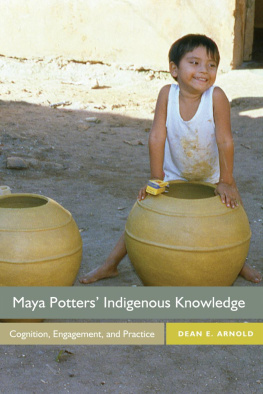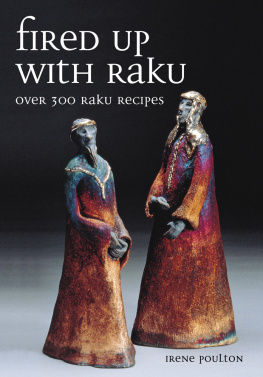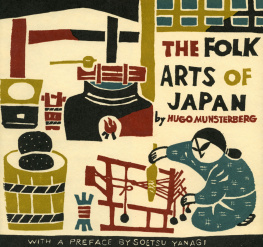
Folk Art Potters of Japan
Beyond an Anthropology of Aesthetics
ANTHROPOLOGY OF ASIA SERIES
Series editor
Grant Evans
University of Hong Kong
Asia today is one of the most dynamic regions of the world. The previously predominant image of timeless peasants has given way to the image of fast-paced business people, mass consumerism and high-rise urban conglomerations. Yet much discourse remains entrenched in the polarities of East vs. West, Tradition vs Change. This series hopes to provide a forum for anthropological studies which break with such polarities. It will publish titles dealing with cosmopolitanism, cultural identity, representations, arts and performance. The complexities of urban Asia, its elites, its political rituals, and its families will also be explored.
Dangerous Blood, Refined Souls
Death Rituals among the Chinese in Singapore
Tong Chee Kiong
Anthropology and Colonialism in Asia
Reflections on the Japanese, Dutch, Chinese, and Indian Experiences
Edited by Jan van Bremen and Akitoshi Shimizu
Hong Kong
The Anthropology of a Chinese Metropolis
Edited by Grant Evans and Maria Tam
Folk Art Potters of Japan
Beyond an Anthropology of Aesthetics
Brian Moeran
First published in 1997
by Curzon Press
This edition published 2013 by Routledge
2 Park Square, Milton Park, Abingdon, Oxon OX14 4RN
711 Third Avenue, New York, NY 10017
Routledge is an imprint of the Taylor & Francis Group, an informa business
1997 Brian Moeran
Typeset by LaserScript, Mitcham, Surrey
All rights reserved. No part of this book may be reprinted or reproduced or utilised in any form or by any electronic, mechanical, or other means, now known or hereafter invented, including photocopying and recording, or in any information storage or retrieval system, without permission in writing from the publishers.
British Library Cataloguing in Publication Data
A catalogue record for this book is available from the British Library
Library of Congress in Publication Data
A catalogue record for this book has been requested
ISBN 0700706054
Fuji no shirayuki
Asahi ni tokete
Tokete nagarete
Mishima ni ochiru.
Mishima jorshu no
Kesh no mizu.
The white snow on Mt. Fuji
Melts in the morning sun,
Melts and flows down,
Flows down to Mishima.
And in Mishima the prostitutes.
Use it in their makeup.
Popular Ballad
For Anchan
and
In Memory of Sakamoto Fujio
CONTENTS
This book is about a group of potters who live in a small community called Sarayama in the south of Japan and who make what is known as Onta ware. It concerns certain problems arising from the production, marketing, and aesthetic appraisal of a kind of stoneware pottery that is generally referred to as a folk art or folk craft (mingei in Japanese).
When I first published the results of my research, in Lost Innocence: folk craft potters of Japan, I used the phrase folk craft to translate mingei. During the decade and a half since it was first written, however, I have come to feel that my usage was a little too purist. After all, one of the points made then (and repeated here) is that as in other forms of art appreciation people have different interpretations about what constitutes mingei depending on their position in the art world: for the potters whom I studied, Onta pottery was little more than a craft; for Yanagi Setsu, founder of the Japanese Mingei movement, and other connoisseurs, it was closer to folk craft; while for dealers and the general public, it could easily shift to being a folk art, art-craft, or even art. However, all of them used the term mingei, and all of them knew precisely what mingei meant for them. As I have had occasion to remark elsewhere in the context of the language of aesthetics, keywords like mingei (as well as shibui, sabi, wabi and a host of other, apparently untranslatable, terms used to set apart a specifically Japanese appreciation of beauty) serve to disguise differences of opinion and so to unite aesthetically like-minded people into an art world. In view of all this, I shall here use the phrases mingei, arts and crafts, folk craft, and folk art fairly indiscriminately, since my concern is not with definitional problems so much as with the social and ideological processes surrounding the production, marketing, appreciation, interpretation and discussion of a certain kind of pottery in Japan.
There are two further reasons to justify this terminological eclecticism. Firstly, pottery holds a position in Japans aesthetic hierarchy which is far and away superior to its position in say British or American arts, and certain kinds of Japanese pottery, particularly when connected with the tea ceremony, are often regarded as Art (with a capital A). During the post-war years, such appreciation has enabled one or two mingei potters most notably Hamada Shji to produce work that has been given the highest artistic accolade, not only in Japan but also in Europe and America. It is probably Japans own aesthetic valuation of pottery as well as that countrys emergence as a top-ranking economic power since the 1970s and 80s, the international recognition of certain Japanese potters (whose fame abroad in some cases stemmed primarily from their early involvement in the Japanese Mingei movement), and a handful of serious collectors which has prompted certain European auction houses from the mid-1980s to try to raise the western category of pottery from craft to art (i.e. to ceramics) by handling the works of, among others, Hans Coper, Lucie Rie, Michael Cardew, Elizabeth Fritch, and Bernard Leach (whose pots already commanded higher prices in Japan than they did elsewhere).
Secondly, the use of a single fixed category is also made difficult by the fact that processes of production and appreciation of folk art works are two-way. The argument put forward in this book is that the development of the concept of Japanese mingei in Japan owed much to the ideas of William Morris and the Arts and Crafts movement in Britain in the late nineteenth century. Nowadays, though, many European and American studio potters have taken on board Yanagi Setsus mingei philosophy often as part of an aesthetic exoticism which has existed between Europe and Japan, at least since 1688, when John Stalker and George Parker first published A Treatise of Japanning or Varnishing. It is thus virtually impossible to disentangle satisfactorily all those terms connected with arts and crafts mentioned above, since mingei is a world-wide phenomenon not just appreciated but practised by potters in Europe and the Americas, as well as in Japan. In other words, nowadays art works by whatever name are everywhere designed, thought about, made, collected and consumed in a world system in which different values are brought to bear by different people in different contexts, depending on their aims and intentions. It is the intricacies of the functioning of this global system that have prompted me here to argue for an anthropology of values








